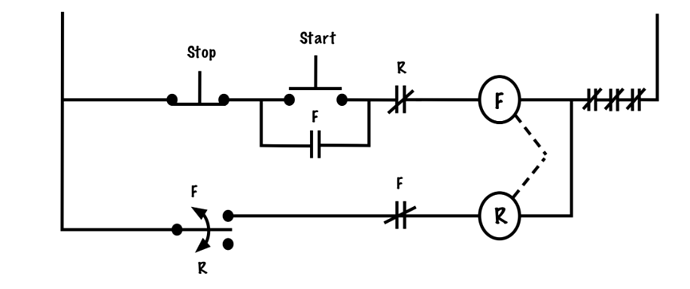When a motor is de-energized, the shaft continues to spin until inertia and friction cause it to slow down and come to a halt. If this condition is undesirable (for example, if we want the motor to stop instantly), we can use a plugging circuit, which requires a forward / reverse motor starter and a zero-speed switch.
Although the motor operates in one direction only, a reversing magnetic starter is needed.
A zero-speed switch is a switch that is activated by centrifugal forces and is attached either directly or via a belt to the shaft of the motor. To provide plugging action, the zero-speed switch must be wired normally open so that any motion of the motor shaft will cause the contacts to change their state and close.
To plug a motor to a stop, the circuit momentarily reverses the motor while it is rotating in the forward direction, but then de-energizes it before it can build up any momentum in the reverse direction.
Under normal operating conditions, the motor is started in the forward direction by pressing the start button. This energizes the forward coil and closes the normally open 2-3 holding contact in parallel with the start button as well as opening the normally open electrical interlocks in series with the reverse coil.
The motor will continue to run and the circuit will operate as a standard three-wire circuit providing low-voltage protection (LVP) until either the stop button is pressed, or an overload occurs.
While the shaft of the motor is spinning, the contacts of the zero-speed switch will change their state, and the forward contact will close. This contact is wired in series with the reverse coil, but cannot energize it so long as the electrical interlock remains open.
When the stop button is pushed, the forward coil is de-energized, dropping out its armature. This causes all the contacts associated with that coil to return to their normal condition, including the normally closed electrical interlock.
Since the shaft of the motor is still spinning in the forward direction due to inertia, the normally open zero-speed switch contacts are being held closed. This means that the instant the stop button is pressed, the reverse coil gets energized, momentarily sending the motor in the reverse direction and cancelling out all of its forward momentum, thus bringing the motor to a halt much quicker.
The instant that the shaft of the motor begins to move in the reverse direction, the held-closed forward contacts of the zero-speed switch open and the reverse coil is de-energized before the motor can build up any momentum in the reverse direction.
The motor has now been plugged to stop. In practice, this all takes place in a fraction of a second.
Reference
Basic Motor Control by Aaron Lee and Chad Flinn is used under a CC BY 4.0 Licence.
